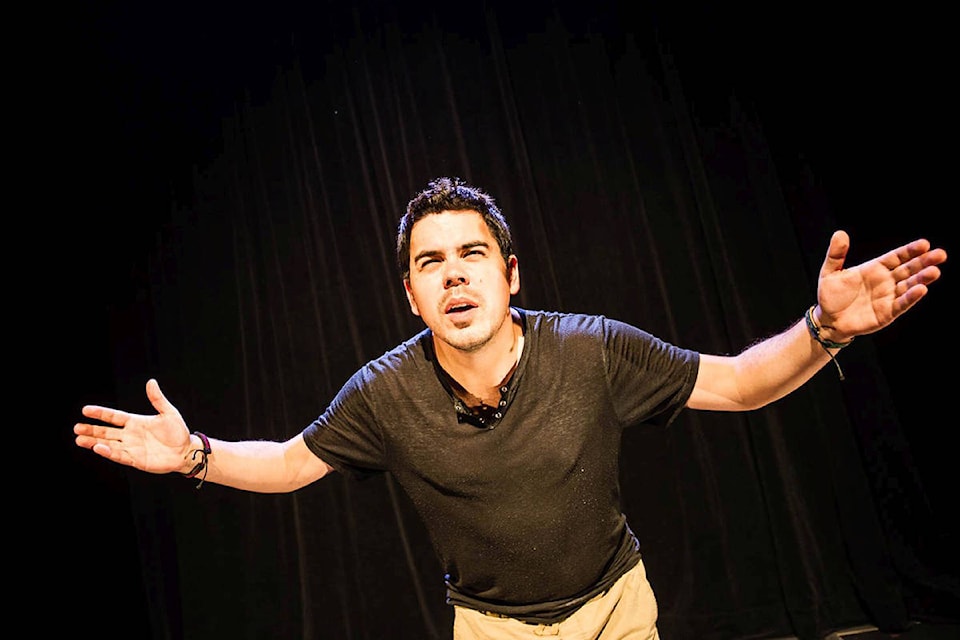The Truth and Reconciliation Commission issued its 94 calls to action in 2015.
The City of Victoria declared 2017 a Year of Reconciliation and appointed its first Indigenous Artist in Residence, Lindsay Delaronde, whose mandate has been extended for another year. What is being done locally to decolonize theatre? Here’s a small sample of some recent initiatives.
For Delaronde, “the future is indigenous”. She points out Indigenous artists are not “stuck in the past” and have continued to evolve their artistic practices far beyond the traditional colonial view of what it is to be Indigenous.
She challenges organizations, creators and audiences to embrace the need for alternative narratives, and new ways of engaging in relationship—to change the dynamics. Her first major festival, Pendulum (February 2017), in collaboration with the Belfry Theatre, featured Indigenous artists from Victoria, Vancouver Island and across the country. Her next festival – Super Nova (Jan. 10-12, 2019) – is based on the theme of creation and the sometimes violent action involved. “Think of the compression necessary before the explosion of a super nova”, she says.
Over its 40-year history, the Belfry has staged and premiered works by Indigenous artists, including Where the Blood Mixes, Urban Tattoo, The Rez Sisters and, this past season, Salt Baby by Falen Johnson who has also been commissioned to write a new work. The upcoming season includes Bears by Matthew McKenzie.
Recently the theatre created the position of Indigenous Cultural Advisor and hired Kristy Charlie. Her role is threefold: provide basic and ongoing cultural competency training for the Belfry’s staff and board, assist in ensuring a supportive, safe and valuable space for participants of the Indigenous Learning Exchange program and other Indigenous guest artists, and work with staff to strengthen existing relationships with local Indigenous Nations.
“We wanted to address our relationship with indigenous artists and inclusion in a more substantial way,” Belfry artistic director Michael Shamata says about the position, which may be unique in Canadian theatre.
In a first for Intrepid Theatre, this year’s UNO Fest included a Guest Indigenous Curator, Yolanda Bonnell and a spotlight on Indigenous women’s voices.
Bonnell wanted to do more than curate one show—as a result a complete program was developed in collaboration with the Victoria Native Friendship Centre. The festival also hired an Indigenous Engagement and Outreach Assistant as part of the team.
Bonnell advises audiences, “when looking for work that can change the course of Indigenous theatre on Turtle Island, look to the Indigenous women that are making art. There are strong, loud, proud, creative, intelligent warrior women out there writing and creating ground breaking work. Indigenous women are leaders.”
This is the second year the Victoria Fringe Festival is offering the Indigenous Artist Program lottery, which includes mentorship before the Fringe Festival. This year’s participant is Logan Keewatin Richards with Reminiscences of Reconciliation – a tale that takes us back 50,000 years in time.
Also appearing at the Fringe is Rocko and Nakota: Tales from the Land by Anishinabe artist Josh Languedoc, who won the coveted CAFF Lottery guaranteeing admission into a minimum of five Fringe festivals.
Delaronde dreams of an Indigenous Performative Arts Centre in Victoria and points to Canadian trailblazers like Native Earth (Toronto) and Full Circle: First Nations Performance (Vancouver). “I want to create space locally,” she states.
